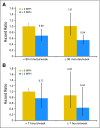Physical activity and survival after prostate cancer diagnosis in the health professionals follow-up study
- PMID: 21205749
- PMCID: PMC3056656
- DOI: 10.1200/JCO.2010.31.5226
Physical activity and survival after prostate cancer diagnosis in the health professionals follow-up study
Abstract
Purpose: To determine whether higher physical activity after prostate cancer (PCa) diagnosis decreases risk of overall and PCa-specific death.
Patients and methods: We evaluated physical activity in relation to overall and PCa mortality among 2,705 men in the Health Professionals Follow-Up Study diagnosed with nonmetastatic PCa observed from 1990 to 2008. Proportional hazards models were used to evaluate physical activity and time to overall and PCa-specific death.
Results: Among men who lived at least 4 years after their postdiagnosis physical activity assessment, we documented 548 deaths, 20% of which were a result of PCa. In multivariable analysis, men who were physically active had lower risk of all-cause mortality (P(trend) < .001) and PCa mortality (P(trend) = .04). Both nonvigorous activity and vigorous activity were associated with significantly lower overall mortality. Those who walked ≥ 90 minutes per week at a normal to very brisk pace had a 46% lower risk of all-cause mortality (hazard ratio [HR] 0.54; 95% CI, 0.41 to 0.71) compared with shorter durations at an easy walking pace. Men with ≥ 3 hours per week of vigorous activity had a 49% lower risk of all-cause mortality (HR, 0.51; 95% CI, 0.36 to 0.72). For PCa-specific mortality, brisk walking at longer durations was suggestively inverse but not statistically significant. Men with ≥ 3 hours per week of vigorous activity had a 61% lower risk of PCa death (HR, 0.39, 95% CI, 0.18 to 0.84; P = .03) compared with men with less than 1 hour per week of vigorous activity. Men exercising vigorously before and after diagnosis had the lowest risk.
Conclusion: In men with PCa, physical activity was associated with lower overall mortality and PCa mortality. A modest amount of vigorous activity such as biking, tennis, jogging, or swimming for ≥ 3 hours a week may substantially improve PCa-specific survival.
Conflict of interest statement
Authors' disclosures of potential conflicts of interest and author contributions are found at the end of this article.
Figures

References
-
- American Cancer Society. Atlanta, GA: American Cancer Society; 2010. Cancer Facts and Figures 2010.
-
- American Cancer Society. Atlanta, GA: American Cancer Society; 2009. Cancer Facts and Figures 2009.
-
- Meyerhardt JA, Giovannucci EL, Holmes MD, et al. Physical activity and survival after colorectal cancer diagnosis. J Clin Oncol. 2006;24:3527–3534. - PubMed
-
- Meyerhardt JA, Heseltine D, Niedzwiecki D, et al. Impact of physical activity on cancer recurrence and survival in patients with stage III colon cancer: Findings from CALGB 89803. J Clin Oncol. 2006;24:3535–3541. - PubMed
-
- Holmes MD, Chen WY, Feskanich D, et al. Physical activity and survival after breast cancer diagnosis. JAMA. 2005;293:2479–2486. - PubMed
Publication types
MeSH terms
Grants and funding
LinkOut - more resources
Full Text Sources
Medical

